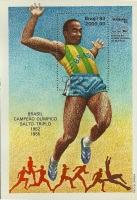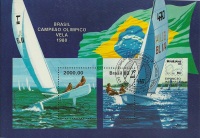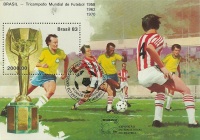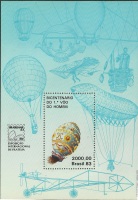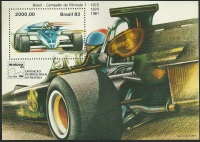Commemorative Stamps of Brazil (no.74)
By William Kriebel
The following article was published in the July-September 2011 issue of The Bull's Eyes (Volume 42, Number 3) as the 74th in a series of articles about Brazilian commemorative stamps. This one primarily focuses on souvenir sheets issued during 1982-83.
BRAPEX V
Issued 17 April 1982
The Fifth Brazilian Philatelic Exhibition was held in Blumenau, Santa Catarina State, 17-25 April 1982. To mark the event the ECT issued a miniature sheet featuring three orchids, a plant mainly found in that State:
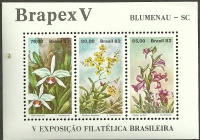 Laelia purpurata Lindl. (left) The most important orchid,
not only due to its extraordinary beauty, but to its 300
varieties found deep into the forests, where it grows as an
epiphyte (a plant that grows on or is attached to another
plant), and over the rocks along the coast where it grows as rupestrian. Due to large exploitation and exportation, this
specimen is almost extinct.
Laelia purpurata Lindl. (left) The most important orchid,
not only due to its extraordinary beauty, but to its 300
varieties found deep into the forests, where it grows as an
epiphyte (a plant that grows on or is attached to another
plant), and over the rocks along the coast where it grows as rupestrian. Due to large exploitation and exportation, this
specimen is almost extinct.
Oncidium flexuosum Sims. (middle) Largely diffused as an
epiphyte in the south, especially in Santa Catarina, its
deep yellow flowers often gathered in large and beautiful
inflorescences, it is called “golden shower” (chuveiro de
ouro). Easily cultivated, it is usually found in garden
trees and squares.
Cleistes revoluta (Rodr) Schltr. (right) Found on brushwoods
along the roads of the coast in the south region of Brazil.
Its flowers are light purple; the labellum, deep wine
colored in the extremities is wrinkled and lobate.
50th Anniversary of the Constitutionalist Revolution
Issued 9 July 1982
In 1930, with the Liberal League, the people waited for a
change of the political structure, not the prolongation of
the dictatorship that was contrary to their traditions.
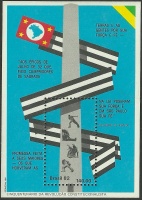 On 9 July 1932, the State of São Paulo and the region that
today corresponds to the State of Mato Grosso do Sul rose up
in arms, with repercussion throughout the country. Uprisings
happened in Rio Grande do Sul, Parana and Minas Gerais.
Popular manifestations took place in Para, Bahia, Rio and
elsewhere.
On 9 July 1932, the State of São Paulo and the region that
today corresponds to the State of Mato Grosso do Sul rose up
in arms, with repercussion throughout the country. Uprisings
happened in Rio Grande do Sul, Parana and Minas Gerais.
Popular manifestations took place in Para, Bahia, Rio and
elsewhere.
The revolutionaries’ sacrifice (deaths, mutilations, arrests
and exiles) became the definitive victory with the
convocation of the Constituent of 1934.
To perpetuate the constitutionalists' patriotism, a monument
was built in Ibirapuera’s Park, in downtown São Paulo.
This obelisk is 77 meters high and bears the words of Guilherme de Almeida:
“Dedicated to the heroes of July, 1932, who fulfilled the sacred promise made to their forebears. Those who conquered the land by their courage and faith—in law they put their strength and in São Paulo they put their faith.”
The souvenir sheet includes an artist’s rendering of the monument wrapped in a stylized flag of the State of São Paulo.
125th Anniversary of Baden Powell’s Birth
75th Anniversary of Scouting
Issued 21 August 1982
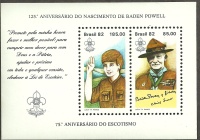 The first camping for boys was held in
England in 1907, with the
purpose of teaching how to know the forest’s poetry and the
discipline of the explorer’s life, and involved
twenty-one youths.
The first camping for boys was held in
England in 1907, with the
purpose of teaching how to know the forest’s poetry and the
discipline of the explorer’s life, and involved
twenty-one youths.
In 1908 Powell published a book Scouting for Boys. The
motto “Be Prepared” (which includes his initials) was
modified in Brazil into “Always Prepared to Serve” (Sempre
Alerta para Servir).
The souvenir sheet includes a young Scout and a
portrait of Robert Baden Powell (1857-1941).
LUBRAPEX-82
9th Luso-Brasileira Philatelic Exhibition
Issued 15 October 1982
This Portuguese-Brazilian exhibition was held 15-25 October
in Curitiba, Parana.
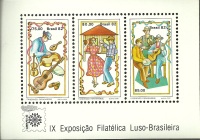 The Fandango from Parana is composed of a series of
marcas
(dances), whose choreography changes according to their
names, e.g., anu, dondum, sabia, etc.
The Fandango from Parana is composed of a series of
marcas
(dances), whose choreography changes according to their
names, e.g., anu, dondum, sabia, etc.
This souvenir sheet pictures the rustic musical
instruments that make up a Fandango Band: the
rabeca (a kind
of violin), the adufo (tambourine), the viola (guitar) and
the most characteristic of them all, the peasant’s sabot,
with which they beat the time for the dancers.
The middle stamp shows dancers in front of the “Fandango
Hall,” where the dances are held. The third stamp pictures a
Fandango Band with their rough, native instruments. The
bright colored ribbons enclosing each scene represent the
jollity, and are often seen in the dancers' garments.
BRASILIANA 83
Issued 18 December 1982
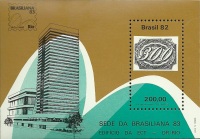 With Sugar Loaf stylized in the background, and the
buildings of the Regional Administration of the ECT in Rio
de Janeiro—where the exhibition was held—and a
reproduction of the 300 reis “Inclinado” stamp, this souvenir
sheet was designed as a publicity offering for the
international philatelic exhibition to be held the following
year. The date of issue is the anniversary of the Brazilian
Federation of Philately (founded in 1976) and the Clube
Filatélico do Brasil (admitted to FIP in 1947).
With Sugar Loaf stylized in the background, and the
buildings of the Regional Administration of the ECT in Rio
de Janeiro—where the exhibition was held—and a
reproduction of the 300 reis “Inclinado” stamp, this souvenir
sheet was designed as a publicity offering for the
international philatelic exhibition to be held the following
year. The date of issue is the anniversary of the Brazilian
Federation of Philately (founded in 1976) and the Clube
Filatélico do Brasil (admitted to FIP in 1947).
500th Anniversary of the Birth of Raphael Sanzio
Issued 25 May 1983
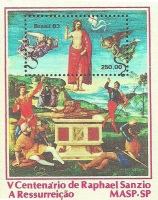 Born in Urbino, Italy, and growing up in Florence, a
contemporary of Michelangelo, Raffaello became one of the
Renaissance’s most famous painters. He is known by his first
name, and had a short life, dying at 33.
Born in Urbino, Italy, and growing up in Florence, a
contemporary of Michelangelo, Raffaello became one of the
Renaissance’s most famous painters. He is known by his first
name, and had a short life, dying at 33.
The souvenir sheet shows his “Resurrection,” which belongs
to the Assis Chateaubriand Museum of Modern Art of São Paulo
and is the only example of his work in Latin America (at
as of 1983). It is believed to have been painted in his
youth (1502-03). The Museum bought the painting in 1954. At
the time, there was some controversy as to whether it was a
real Raphael. This was apparently resolved when studies at
Oxford, England, discovered preparatory sketches leading to
the painting, thus confirming Raphael’s authorship.
BRASILIANA 83
140th Anniversary of the Bull’s Eyes
Issued 29 July 1983
Less than a year after the first postage stamp was issued in
England, Dom Pedro II signed a law adopting the use of
postage stamps in Brazil. The law was implemented the
following year, when the face values of 30, 60 and 90 “reis”
(plural of real, the
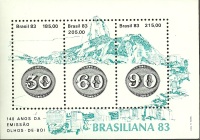 former unit of the Portuguese and
Brazilian monetary system) were attributed to the stamps,
and became effective on 1 August 1843, the date of issue.
former unit of the Portuguese and
Brazilian monetary system) were attributed to the stamps,
and became effective on 1 August 1843, the date of issue.
Commemoration of the stamps coincided with the International
Exposition held in Rio de Janeiro, 29 July-7 August 1983.
In addition to this souvenir sheet, three stamps in full (55 stamps) sheets were also issued with a similar design, except the reproductions of the “Bull’s Eyes” are at the top, with the sketch of Rio below, and in three different colors.
A set of five souvenir sheets (below), was also issued, and they were apparently only available at the show, and unsold items were destroyed when the show closed (see note in RHM). This procedure, as well as their high face value (2000,00) is reflected in their high (RHM) catalog value. It also resulted in their being excluded from the Scott Catalogue. Scott at that time was “blackballing” so-called “limited editions” from a variety of countries. I do not know whether that process continues. It certainly did not apply to the two U.S. sheets issued in connection with PACIFIC 97 (#3139-40) which reproduced our first two stamps in 50¢ and 60¢ versions, resulting in $6.00 and $7.20 (12 stamps per sheet) “souvenirs”!
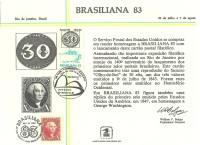 The U. S. Postal service participated in this show and
produced a souvenir card which bore
reproductions of the 30 reis and the 10¢ George Washington
of 1847, the first issue of the United States. (Matching
stamps added and show-canceled.)
The U. S. Postal service participated in this show and
produced a souvenir card which bore
reproductions of the 30 reis and the 10¢ George Washington
of 1847, the first issue of the United States. (Matching
stamps added and show-canceled.)The USPS no longer issues souvenir cards (the last one being in 1992, for OLYMPHILEX held in Barcelona, Spain). Ironically, their first show participation was also in Barcelona, in 1960.
As I was preparing this issue to go to the printer, I received my copy of Linn’s Stamp News (June 13, 2011). In the “Stamp Market Tips” column by Henry Gitner, he writes: “The market for Brazilian stamps is getting better as the Brazilian economy improves.
“This set of souvenir sheets has great and wide topical appeal. A set recently sold in an online auction for $140 with multiple bidders battling down to the wire for it.
“Shop around, and you might be able to find this set of five souvenir sheets at a really inexpensive price from a lazy dealer who hasn’t bothered to track the market for them.”
Scott’s value, at last note, was $35 each. RHM lists them at R180,00 or about $90 each! If you don’t already have them, I suggest you take Henry’s advice, if you can find a dealer who has them, or even knows where Brazil is! There aren’t that many!

